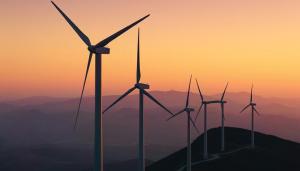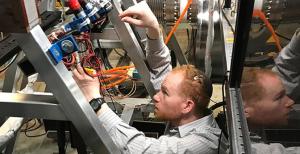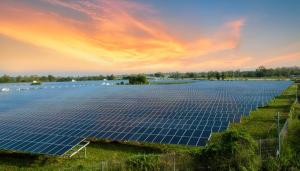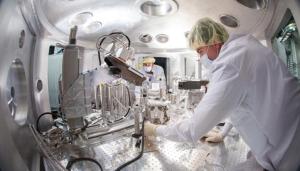LAB REPORT
Science and Technology Making Headlines
April 22, 2022


Researchers at LLNL and the UC Berkeley demonstrated the ability to 3D-print microscopic objects in silica glass through volumetric additive manufacturing (VAM), part of an effort to produce delicate, layer-less optics that can be built in seconds or minutes. Image by Adam Lau/Berkeley Engineering.
As hard as glass
Versatile and ubiquitous, glass is increasingly found in specialized applications such as fiber optics, consumer electronics and microfluidics for "lab-on-a-chip" devices. However, traditional glassmaking techniques can be costly and slow, and 3D-printing glass often results in rough textures, making them unsuitable for smooth lenses.
Using a new laser-based Volumetric Additive Manufacturing (VAM) approach — an emerging technology in near-instant 3D printing — researchers at Lawrence Livermore (LLNL) and the UC Berkeley have demonstrated the ability to 3D-print microscopic objects in silica glass, part of an effort to produce delicate, layer-less optics that can be built in seconds or minutes.
Nicknamed "the Replicator" after the fictional device in "Star Trek" that can instantly fabricate nearly any object, the Computed Axial Lithography (CAL) technology developed by LLNL and UC Berkeley is inspired by computed tomography (CT) imaging methods. CAL works by computing projections from many angles through a digital model of a target object, optimizing these projections computationally, and then delivering them into a rotating volume of photosensitive resin using a digital light projector.
Combining a new microscale VAM technique called micro-CAL, which uses a laser instead of an LED source, with a nanocomposite glass resin developed by the German company Glassomer and the University of Freiburg, UC Berkeley researchers reported the production of sturdy, complex microstructure glass objects with a surface roughness of just six nanometers with features down to a minimum of 50 microns.


In 2021, wind power increased by 11 percent. Credit: Adobe Stock.
A mighty wind
In 2021, Americans used 5% more energy than in 2020, according to the most recent energy flow charts released by Lawrence Livermore National Laboratory (LLNL).
Each year, LLNL releases flow charts that illustrate the nation's consumption and use of energy. In 2021, Americans used 97.3 quads (quadrillion BTU) of energy, which is 4.4 quads more than last year’s 92.9 quads, equivalent to a 5% increase. Both 2020 and 2021 annual energy consumption totals are less than 2018 and 2019, where Americans used more than 100 quads per year. A BTU, or British Thermal Unit, is a unit of measurement for energy; a BTU is the amount of heat it takes to raise 1 pound (~1 pint) of water by 1 degree Fahrenheit. 3,412 BTUs is equivalent to 1 kilowatt-hour, which is the amount of energy it takes to light an efficient LED lightbulb for a week.
Solar and wind energy production increased drastically this past year, with jumps of 20% and 11%, respectively; biomass-derived energy also increased by 7%. These increases contrasted with hydro, geothermal and nuclear power, which decreased by 12%, 4% and 1%, respectively. The large drop in hydropower is due to exceptional drought condition.


LLNL physicist James Mitrani sets up scintillator detectors to measure neutrons on the University of Washington’s Fusion Z-Pinch Experiment (FuZE) device.
Pinch me I must be dreaming
In findings that could help advance another “viable pathway” to fusion energy, research led by Lawrence Livermore National Laboratory (LLNL) physicists has proven the existence of neutrons produced through thermonuclear reactions from a sheared-flow stabilized Z-pinch device.
The researchers used advanced computer modeling techniques and diagnostic measurement devices honed at the Lab to solve a decades-old problem of distinguishing neutrons produced by thermonuclear reactions from ones produced by ion beam-driven instabilities for plasmas in the magneto-inertial fusion regime.
While the team’s previous research showed neutrons measured from sheared-flow stabilized Z-pinch devices were “consistent with thermonuclear production, we hadn’t completely proven it yet,” said LLNL physicist Drew Higginson.
“This is direct proof that thermonuclear fusion produces these neutrons and not ions driven by beam instabilities,” said Higginson, principal investigator of the Portable and Adaptable Neutron Diagnostics (PANDA) team that is doing research under a Department of Energy Advanced Research Projects Agency-Energy (ARPA-E) cooperative agreement. “It’s not proven they’re going to get energy gain, but it is a promising result that suggests they are on a favorable path.”


Solar energy production increased drastically in 2021 with a jump of 20%.
A place in the sun
Solar and wind energy production increased drastically this past year, with jumps of 20% and 11%, respectively; biomass-derived energy also increased by 7%. These increases contrasted with hydro, geothermal and nuclear power, which decreased by 12%, 4% and 1%, respectively, according to the most recent energy flow charts released by Lawrence Livermore National Laboratory
The large drop in hydropower is due to exceptional drought conditions in the western United States. While hydroelectric power generation dominated the renewable energy sector for decades, solar and wind energy appear to be gaining a commanding lead — producing more than double the electricity of hydroelectric power in 2021.
“As climate change continues to impact the global hydrologic cycle, I believe we will continue to observe greater growth in solar and wind energy sectors than hydropower,” said Kimberley Mayfield, co-principal investigator for LLNL’s Energy Flow Charts.


Researchers work in the “MEC hutch” of SLAC’s LCLS Far Experiment Hall. The MEC optical laser system creates extreme temperatures and pressures in materials and the LCLS X-ray laser beam captures the material’s response. Image by Matt Beardsley/SLAC.
Coming into power
Lawrence Livermore National Laboratory’s decades of experience in developing high-energy lasers is now being tapped to provide a key component of a major upgrade to the U.S. SLAC National Accelerator Laboratory’s Linac Coherent Light Source, located at Stanford University.
Over the next several years, LLNL’s Advanced Photon Technologies program is scheduled to design and construct one of the world’s most powerful petawatt (quadrillion-watt) laser systems for installation in an upgraded Matter in Extreme Conditions (MEC) experimental facility at LCLS, funded by the Department of Energy’s Office of Science-Fusion Energy Sciences program.
The new laser will pair with the LCLS X-ray free-electron laser to advance the understanding of high-energy density physics, plasma physics, fusion energy, laser-plasma interactions, astrophysics, planetary science and other physical phenomena.





